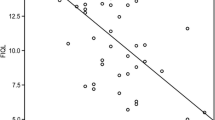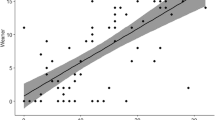Abstract
Introduction and hypothesis
The main aim of this study was to validate the Turkish translated version of the Wexner scale.
Methods
After establishing the test–retest reliability and internal consistency of the Turkish version of Wexner scale on 31 patients, total and subscale scores and anal manometric measurements of 60 participants were performed. Correlation between Wexner scale scores and manometric measurement values were analyzed and those values of patients with or without anal incontinence symptoms were compared.
Results
Of the 60 participants, 47 (78%) showed no signs or symptoms of anal incontinence. Wexner scale showed a high internal consistency (Cronbach’s alpha = 0.816). Total and each subscale score of Wexner scale showed strong correlation with resting and maximal squeeze pressures and between each other (p < 0.005). The pressure values were significantly less in asymptomatic patients compared to patients with any degree of symptoms (p < 0.05).
Conclusion
The Turkish translated version of the Wexner scale is a reliable, consistent, and valid instrument to evaluate anal functions in women with anal incontinence for Turkish speaking women. Total and subscale scores of the Wexner scale and anal manometric measurements showed significant correlation.
Similar content being viewed by others
References
Perry S, Shaw C, McGrother C, Matthews RJ, Assassa RP, Dallosso H, Williams K, Brittain KR, Azam U, Clarke M, Jagger C, Mayne C, Castleden CM (2002) Leicestershire MRC Incontinence Study Team. Prevalence of faecal incontinence in adults aged 40 years or more living in the community. Gut 50:480–484
Melville JL, Fan M-Y, Newton K, Fenner D (2005) Fecal incontinence in US women: a population-based study. Am J Obstet Gynecol 193:2071–2076
Zetterström JP, López A, Anzén B, Dolk A, Norman M, Mellgren A (1999) Anal incontinence after vaginal delivery: a prospective study in primiparous women. Br J Obstet Gynaecol 106:324–330
Pollack J, Nordenstam J, Brismar S, Lopez A, Altman D, Zetterstrom J (2004) Anal incontinence after vaginal delivery: a five-year prospective cohort study. Obstet Gynecol 104:1397–1402
Meschia M, Buonaguidi A, Pifarotti P, Somigliana E, Spennacchio M, Amicarelli F (2002) Prevalence of anal incontinence in women with symptoms of urinary incontinence and genital prolapse. Obstet Gynecol 100:719–723
Gordon D, Groutz A, Goldman G, Avni A, Wolf Y, Lessing JB et al (1999) Anal incontinence: prevalence among female patients attending a urogynecologic clinic. Neurourol Urodyn 18:199–204
Jorge JM, Wexner SD (1993) Etiology and management of fecal incontinence. Dis Colon Rectum 36:77–97
Rockwood TH (2004) Incontinence severity and QOL scales for fecal incontinence. Gastroenterology 126:S106–S113
Minguez M, Garrigues V, Soria MJ, Andreu M, Mearin F, Clave P (2006) Adaptation to Spanish language and validation of the fecal incontinence quality of life scale. Dis Colon Rectum 49:490–499
Khullar V (2003) Outcome assessment. In: Bent AE, Ostergard DR, Cundiff GW, Swift SE (eds) Ostergard’s urogynecology and pelvic floor dysfunction, 5th edn. Lippincott, Williams & Wilkins, Philadelphia, pp 51–59
Zutshi M, Salcedo L, Hammel J, Hull T (2010) Anal physiology testing in fecal incontinence: is it of any value? Int J Colorectal Dis 25:277–282
Conflicts of interest
None.
Author information
Authors and Affiliations
Corresponding author
Appendix
Appendix
Rights and permissions
About this article
Cite this article
Cam, C., Selcuk, S., Asoglu, M.R. et al. Validation of the Wexner scale in women with fecal incontinence in a Turkish population. Int Urogynecol J 22, 1375–1379 (2011). https://doi.org/10.1007/s00192-011-1464-6
Received:
Accepted:
Published:
Issue Date:
DOI: https://doi.org/10.1007/s00192-011-1464-6




